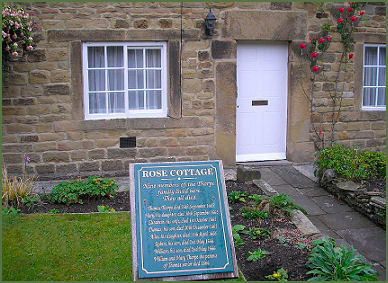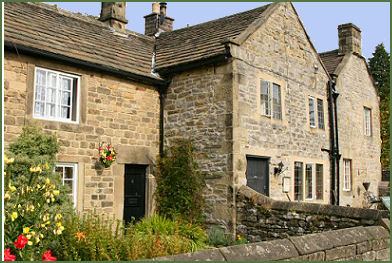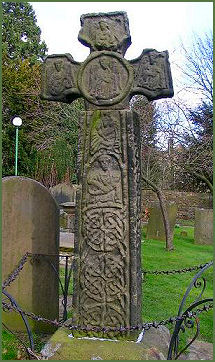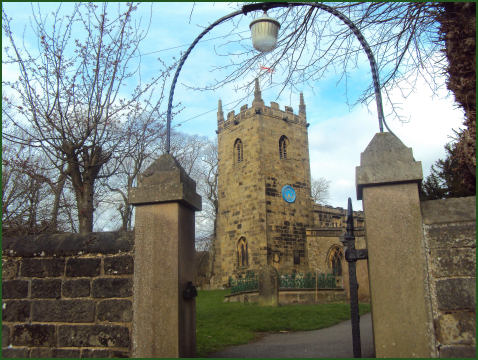Eyam
Grid Ref:
 The characterful village of Eyam, located 5 miles north of Bakewell in the Peak District National Park is famous as the "plague village" that imposed isolation on itself when the bubonic plague broke out there in August of 1665, rather than let the infection spread to neighbouring areas
The characterful village of Eyam, located 5 miles north of Bakewell in the Peak District National Park is famous as the "plague village" that imposed isolation on itself when the bubonic plague broke out there in August of 1665, rather than let the infection spread to neighbouring areas
 Bubonic plague first came to Eyam in the form of a flea-infested parcel of cloth which was delivered to the village tailor, George Viccars, from London, where the plague then raged.
Bubonic plague first came to Eyam in the form of a flea-infested parcel of cloth which was delivered to the village tailor, George Viccars, from London, where the plague then raged.
The cloth was damp and was hung out in front of the fire to dry, thus releasing the plague infested fleas. Viccars the tailor died of a raging fever within a week of receiving the cloth, he was buried on 7th September 1665.
By the end of September, five more villagers had died of the plague. Twenty three more died in October.
As the plague continued to rage among the inhabitants of Eyam, the village rector, the Reverend William Mompesson and the Puritan Minister Thomas Stanley introduced measures to slow the spread of the disease from May 1666. These included arrangements that families were to bury their own dead and the relocation of church services from the parish church of St. Lawrence to Cucklett Delph to allow villagers to separate themselves, reducing the risk of infection.
Finally the entire village quarantined itself from the outside world. The inhabitants received food from the people of the neighbouring villages, who brought supplies and left them at either the Boundary Stones, or at Mompesson's Well, located high above the village. The villagers left payment in a water trough filled with vinegar to sterilise the coins. Those who supplied the food did not come into contact with the villagers. The Earl of Devonshire, who lived at nearby Chatsworth House, freely donated food and medical supplies.
 The Riley graves, near Riley House Farm around half a mile from Eyam, is where the husband and six children of farmer Elizabeth Hancock lie buried. All died within a week of each other. Because of the high risk of infecting her neighbours she had the traumatic task of burying them all herself.
The Riley graves, near Riley House Farm around half a mile from Eyam, is where the husband and six children of farmer Elizabeth Hancock lie buried. All died within a week of each other. Because of the high risk of infecting her neighbours she had the traumatic task of burying them all herself.
Catherine Mompesson, wife of the recently appointed rector William Mompesson, died of the plague on 25th August 1666. She had loyally remained with her husband and tended the sick, only to tragically become a further victim herself.
The plague raged in Eyam for fourteen months, when it finally abated in November 1666, it is believed to have been responsible for the deaths of at least 273 villagers, as recorded in the village church register, only 83 villagers survived. Survival appears to have been random, as many plague survivors had close contact with the bacterium but never caught the disease.
 Even today, there are many local families who are able to trace their ancestry back to the time of the bubonic plague. Researchers found no evidence that the Delta 32 gene mutation had protected the Eyam survivors of the plague, although this mutation was found in a statistically significant number of 14% in direct descendants of the plague survivors. A remembrance service is still held annually at Cucklett Delf in Eyam for the victims every Plague Sunday (the last Sunday in August).
Even today, there are many local families who are able to trace their ancestry back to the time of the bubonic plague. Researchers found no evidence that the Delta 32 gene mutation had protected the Eyam survivors of the plague, although this mutation was found in a statistically significant number of 14% in direct descendants of the plague survivors. A remembrance service is still held annually at Cucklett Delf in Eyam for the victims every Plague Sunday (the last Sunday in August).
 Today there many reminders of this great act of courage and selflessness in Eyam.The Coolstone (pictured above right), a stone in which money, usually soaked in vinegar, which was believed to kill the infection, was placed in exchange for food and medicine, can still be seen and many of the cottages carry a commemorative plaque, information boards at strategic points tell the story and give the details of the families who were so tragically affected.
Today there many reminders of this great act of courage and selflessness in Eyam.The Coolstone (pictured above right), a stone in which money, usually soaked in vinegar, which was believed to kill the infection, was placed in exchange for food and medicine, can still be seen and many of the cottages carry a commemorative plaque, information boards at strategic points tell the story and give the details of the families who were so tragically affected.
Eyam Hall, (pictured left) in the centre of the village has been home of the Wright family for over 300 years, the hall dates from just after the plague.
The unspoilt seventeenth century Manor House contains an impressive stone flagged hall and a unique tapestry room, the nursery has a collection of toys dating from 1860 to the present day, other rooms reveal costumes belonging to the Wright family, precious artifacts and fascinating family momentos. The garden still retains its seventeenth century layout, with a knot garden, bowling green, potager and rose walk.There is also a cafe, gift shop and the interesting Eyam Hall Crafts Centre which is housed in the farm buildings.
Eyam Museum opened in 1994 and includes interesting exhibits on local history in general and the 1665 Plague in particular. The village green boasts an ancient set of stocks.
The village was founded in Anglo-Saxon times and was formerly a centre for lead mining. it is mentioned in the Domesday Book as 'Aium'. The churchyard contains a Celtic cross (pictured right), considered to be one of the best preserved examples in the country, which dates back to the 7th or 8th centuries. The cross was once located at the side of a cart track near Eyam before being moved to the churchyard. It is decorated with complex carvings with a mixture of Christian and pagan symbols and is almost complete, but is missing a section of the shaft.
The village church of St. Lawrence and Eyam Market Hall


The village Church of St Lawrence itself partly dates from the twelfth century but is believed to stand on a Saxon foundation. The building retains a Norman window at the west end of the north aisle, and Norman pillars. It also contains a chair that was used by the Rev William Mompesson, which is thought to have been made by a local carpenter, a Jacobean pulpit, a Plague register and a saxon font. A new stained glass window depicting the plague was installed in the north aisle in the twentieth century. The churchyard contains the graves of a number of the plague victims.
Nearby places of interest
The Longshaw Estate, owned by the National Trust, offers scenic Peak District, views, ancient woodland, parkland and heather moorland.
Peveril Castle, standing majestically on a limestone outcrop at Castleton in the picturesque Hope Valley, Peveril Castle dominates the surrounding landscape. The castle was founded by William Peverel (c. 1040–circa. 1115)
Winnats Pass is situated in the High Peak area of the Peak District National Park and lies to the west of the attractive village of Castleton.
Lathkill Dale A Peak District beauty spot in the truest sense of the word, Lathkill Dale is one of Britain's finest limestone valleys
Arbor Low Stone Circle, sometimes referred to as ‘The Stonehenge of the North', a prehistoric site of unique archaeological and cultural interest. The monument is atmospherically set amid high moorland near the town of Bakewell.
